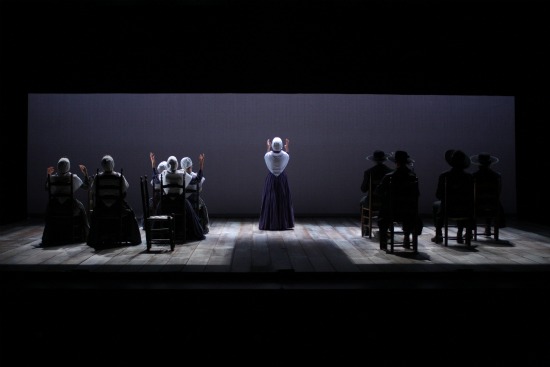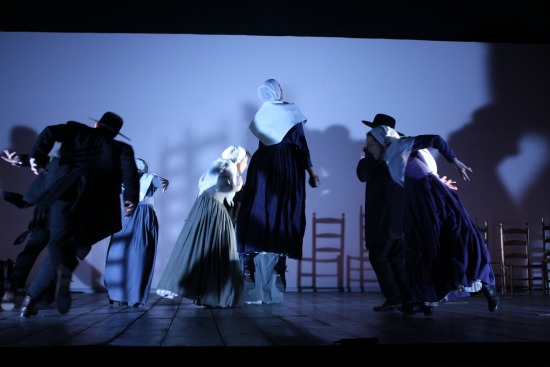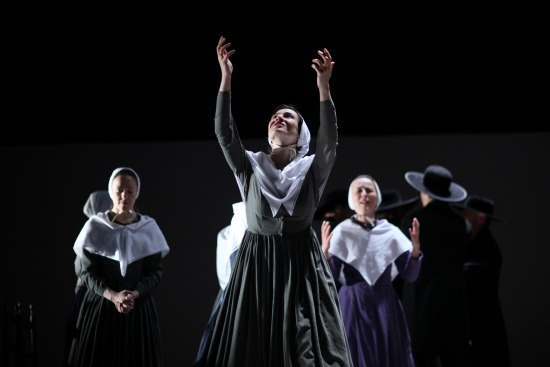What fascinates people about the Shakers—members of religious communities that settled in New England in the late 18th century, proselytized, expanded, and began to wither a hundred or so years later? We marvel at the austerely beautiful furniture they made, their ingenuity, and the fact that they considered drawing, singing, and dancing gifts from God that were to be practiced freely and diligently—all that and more, but what seems to boggle many contemporary minds is that Shakers were celibate.
Doris Humphrey barely hinted at underlying sexual tensions in her ecstatic 1931 dance The Shakers. The Finnish choreographer Tero Saarinen downplayed them in his glorious Borrowed Light (2004). Watching Angel Reapers, which plays at the Joyce Theater through December 11, you get the impression that for its greatly gifted creators, director-choreographer Martha Clarke and playwright Alfred Uhry, Shaker dancing—whether wild or formally patterned—was a sublimation for the erotic physical exertions that the community members denied themselves.
That underlying tug of desire animates some of the drama in Angel Reapers, but it also emerges in much of the dancing that fills this beautifully imagined and constructed theater piece. Under the guidance of music director Arthur Solari, the eleven splendid performers not only sing Shaker hymns a cappella, they stamp out rhythms that build in complexity and contrapuntal textures, whether the actor-dancers are marching over the resonant plank flooring or sitting on straight-backed chairs. With every footfall, you feel these people uniting to assert their control over their bodies and nail illicit urges into the floor. When one man (Patrick Corbin) turns comforting a “brother” into something more sexual, and the two wrestle furiously, several of the “sisters” seated at the back accompany their exertions with a slow, muffled pounding of feet on wood.
Mary Ann Lee, the founder of Shakerism (officially the United Society of Believers in Christ’s Second Appearing), is a character in Angel Reapers—as beset by struggle (although not by carnal urges) as any of her followers. Played by Birgit Huppuch, Mother Ann doesn’t come across as the fierce and charismatic leader she’s reputed to have been; there’s a touching moment when she sings alone in a high, clear voice, seeming frailer than the others who whirl about her in two concentric circles. This moment may be her attempt to calm and unite her “children” after a dance in which they stomp and gallop—bent over, their arms flung out behind them, groaning under their breaths—while Christopher Akerlind’s lighting throws their hulking shadows on the back wall.
Whether frenzied or obdurately controlled, the dance rituals practiced by these Shaker avatars are augmented by Akerlind’s shafts-in-darkness effects and Donna Zakowska’s more-or-less authentic costumes. The men’s long, dark coats flap out behind them when they spring into the air; they look like crows attempting to take off. The women’s long skirts bell out as they spin; tranced worshippers fall in a tangle of petticoats.
The performers provide information by reciting the community’s rules or enumerating the “gifts” they receive from God each day (repairing the henhouse counts). Individually, they report their weaknesses and tell their stories. The program gives them names and identities. Sister Agnes Renard from France (Sophie Bortolussi) lost her three-year-old daughter in the crossing to America. Brother William Lee (Peter Musante) bears the burden of being both Mother Ann’s “child” and her blood brother. Sister Susannah Farrington (Lindsay Dietz Marchant) was an abused wife, and Asli Bulbul as Sister Hannah Cogswell (an actual early Shaker and, according to the program, a former convict) could be re-enacting Cogswell’s own past or Sister Susannah’s when she locks her legs around the other woman’s recumbent form and wrenches her around in circles. Whitney V. Hunter plays an escaped slave, Brother Moses, and his wild-legged clogging is one of the evening’s most joyful moments.
Clarke has ingenious ways of making the trances in which believers whirl and faint and crawl like animals morph into the orderly dances typical of later Shaker religious services. But spiritual revelations are few for these believers, and temptations lurk. Andrew Robinson and Gabrielle Malone play a husband and wife separated by their entry into the community. When they meet as if accidentally and he lifts her and whirls her higher and higher, she slaps his face. Isadora Wolfe and Luke Murphy portray orphans adopted into the society; he shows his growing uneasiness and physical strain early on. He takes down her hair, she unbuttons her bodice and straddles him bare-breasted. They leave the community—he speaking words by the historical Valentine Rathbun accusing the Shakers of various abominations.
I question a couple of Clarke’s and Uhry’s images. One is that of Mother Ann removing her shoes and stockings so that her brother can bathe her feet—an act, I imagine, to stress the image she may have had of herself as Christ-like. Too, it seemed gratuitous near the end of Angel Reapers to have four of the men back in, wearing only their shoes and socks, and exit after a few moments of toil, still stamping vigorously. The idea that Shakers ever danced naked has been argued about by scholars. Was it just a trumped-up charge in the copious amounts of anti-Shaker rant (which seems likely), or did the rumor have a basis?
The more you read about the Shakers, the more you feel their complexity. Consider their innocent ritual when, handed fine invisible raiment, they marched up to dance on a mountaintop, refreshed with imaginary nectar in unseen cups, or the childlike quality of some of their hymns (“Oh my pretty mother’s home/ Sweeter than the honey in the comb”). Compare these to their efficient mercantile dealings with villages outside their precincts and the superbly scientific engineering of, say, the icehouse at Hancock Shaker Village. Contrast the sweet primitivism of their drawings with the elegant simplicity of their furniture.
Angel Reapers does convey the playfulness that occasionally must have offset both decorous behavior and religious hysteria. In the opening scene, one woman’s unsuccessfully repressed giggle gradually incites general hilarity. Later, four women get hold of the corners of a sheet and turn it into a plaything; like the dancers in Doris Humphrey’s Soaring, they make it balloon up and take turns running beneath it before it falls. Who said laundry day was boring? But Clarke and Uhry couldn’t tell you everything about the Shakers in a piece a little over an hour long, and they decided early on against emphasizing Mother Ann’s own story. Instead, they’ve created a powerful and rhythmically resonant dance-drama out of a struggle between flesh and spirit and the documented rituals that both embodied and quelled that conflict.




Thank you for your review. I’m grateful that you questioned the assumption made by Ms. Clarke and Mr. Uhry that the Shakers danced naked. That was untrue! It comes from the “anti-Shaker rant” as you correctly termed it, and should not have been included in this production because it gives a false notion to the audience. I was extremely displeased that this production portrayed the Shakers in such an unfavorable way. How could they have produced so much beautiful furniture and music if they were so repressed? As someone who has studied their music and culture for 40 years and has known the Shakers, who still have a commuinity in Maine, I believe they should be admired for their bringing something beautiful to the world. This production does not due the Shakers justice.
It might have been less historic but more prescient if the community of Shakers portrayed by Clarke and Uhry were all on anti-depressants. Anti-depressants are renowned for killing the libido. (I can speak truth to power on this one). Just think how different the Shakers would have been if they were zoned out for years on prozac. Or they could have been very depressed and kept those urges flying. I wonder if any of the Shakers still practicing Shakerism would stay in the fold if diagnozed for clinical depression.